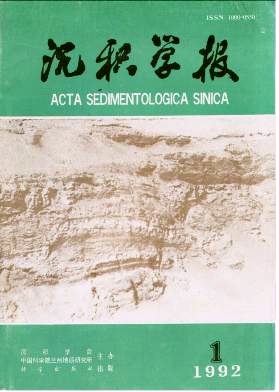Study of Situ-adsorption of Organic Solutes in Montmorillonite
- Received Date: 1991-02-11
- Publish Date: 1992-03-10
Abstract: The new situ-adsorption and measurament system consists of dynamic adsorbed simulation and Fourier Transform Infrarad (FT1R) spectrometer, the situ-adsorption study is particularly important, because it can observes directly adsorbing behaviour from the porous media with montmorillonite bonded on the glass rnicroballs surface. The montmorillonites become various micro- structures of " cloud- sheel", "scalelike", and "assemble-hump" on the surface of glass rnicroballs. The property of the porous media just may be similar to clayrich sandstones. For observation by FTIR spectrometer, the optic element inserting into porous media is a ZnSe crystal of high refractive index and inertness, into which modulation wave beam from FTIR spectrometer is focus-sed at such and angle that it enters the crystal and is internally reflected within it so that the IR beam is trapped. After many reflections the IR beam emerges from the opposite end of the crystal and passes to the detector. At each reflection within the crystal an evanescent wave is produced that penetrates into the porous media in contact with the crystal. If this porous media with montmorillonite and organic solutes absorb infarad, energy will be lost from the crystal (it is attenuated at certain frequency) and corresponding FT-IR spectra can be obtained. Our experiment results of dynamic adsorption confirmed that a realtive organic solutes are singificantly adsobed into montmorillonites and there are both physical and chemical adsorptions on the porous media, simultanneosly.On the basis of situ-adsorbed FTIR spectra data of petroleum sulfoacid group (PSG) into montmorillonite, the high frequency shift 12-39 cm-1 of the OH deforming band of montmorillonite on hydrogen bond formation is accompanied by an increase in intensity and a broadening and splitting double peaks of the band. However bridge bond formtion is low frequency shift 15 cm-1 of CH3 stretching band of PSG. It is indicate that monovalent organic anion, PSG, most enter between both lattice-layers of montmorillonite, because hydrophilic group and ydrophobic group of PSG to conned become bridge bond and hydrogen bond with lattice water and silicon-oxygen group in montmorillorite, respectively. Demonstration a new interest in our experiments that by adequately choosing the PSG concentration (900-1600 ppm, the adsorption density can be substantially increase convert PSG into micelle. Therefore, as mentioned above experimental results, distinct adsorbed behaviour is situ-observed for PSG have a high degree of centralism between both lattice-layers of mintmorillonite to form layer-micelle. We would like to comment that the lattice-layers of montmorillonite is a cryptand of structure of three-dimensional space, that is a "micro-environment" with catalytic property. The montmorillonites of edhydration will be accompained with transport of organic substance from lattice-layers of montmorillonites when montmorillonites change into illites. Therefore, it has geological significance of very mportance, because the results indicated causal relation which a great deal organic substances storage and transport from montmorillonites in the stratum.
| Citation: | Zhou Yanru, Tong Zhenghuo, Yu Dasen. Study of Situ-adsorption of Organic Solutes in Montmorillonite[J]. Acta Sedimentologica Sinica, 1992, 10(1): 118-125. |






 DownLoad:
DownLoad: